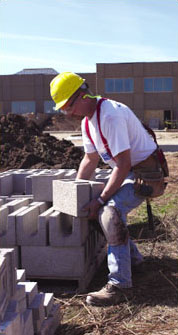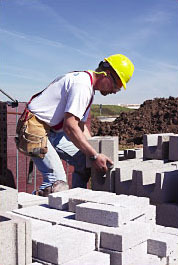Back to Basics: Personnel Safety
 Up and down, twist and turn, raise and lower. Most of us make movements like this every day, but when masons make these repetitive motions continually throughout the workday, back pain can occur. Constantly bending and lifting brick, block and stone can create stress on even healthy backs.
Up and down, twist and turn, raise and lower. Most of us make movements like this every day, but when masons make these repetitive motions continually throughout the workday, back pain can occur. Constantly bending and lifting brick, block and stone can create stress on even healthy backs.
Back pain can be caused by repeatedly lifting materials, awkward positions, sudden movements, lifting and twisting at the same time, and bending over for long periods. Other factors that may contribute to back pain are poor posture, poor physical condition, stress and repetitive trauma. The most common causes of lower back pain are sprains and strains, which are often triggered by improper lifting.
For masons, mason tenders and laborers, the job isn't going to change, so you will continue to lift, twist and perform those repetitive motions. However, there are things you can do to be more proactive.
BLS Statistics
According to the Bureau of Labor Statistics (BLS), sprains and strains - most often involving the back - accounted for 43% of the 1.3 million injuries and illnesses in private industry that required recuperation away from work beyond the day of the incident in 2003.
When sprains and strains, bruises and contusions, cuts and lacerations, and fractures are combined, they accounted for nearly two-thirds of the cases with days away from work.
Sprains and strains were the leading type of injury or illness in every major industry sector in 2003, with 33% of these cases occurring in the trade, transportation and utilities major industry sector.
Think and Look Before You Lift
Many back injuries can be avoided by simply creating a good plan of action. These tips will help you and your crewmembers prevent or reduce back injuries before you even begin to lift:
- Size up the load - Before you lift an object, test the weight by lifting one of the corners. If the load is too heavy or awkward, get help from a co-worker or use a mechanical lifting device. If you must lift it, make sure you can handle the weight.
- Determine the lifting position - The more you bend and reach, the more stressed and tired your back will become. It is harder to lift objects that are far from your body, so the closer the object, the easier it is to lift.
- Bend at the knees - This is the single most important rule to follow when lifting moderate to heavy objects. Professional weightlifters can lift tremendous weights because they lift with their legs, not their backs.
- Get the right grip - The stronger your grasp, the more stable the lift will be. Stress in your back is increased when the load is awkward, bulky, heavy or hard to grasp.
- Stay strong - Eating right and getting regular exercise will help you keep your strength and flexibility. Learn to control stress.
Lift that Load
When lifting a heavy object, whether it is a cement block or heavy stone, follow these step-by-step tips:
- Once again, size up the load before lifting.
- Place your feet close to the object.
- Center yourself over the load.
- Bend your knees.
- Get a good handhold.
- Smoothly, lift straight up.
- Allow your legs, not your back, to do the work.
So the load is lifted... now what?
- Don't twist or turn your body. Keep the load close to the body and keep it steady. Sudden twisting or turning could result in a back injury. Turn with your feet, not with your back.
- Know where you are placing the load before moving it. Be sure the path is clear of obstacles, like tools or equipment, and watch for hazards, such as holes. Be sure of your footing before moving.
- Set the load down properly. This is as important as lifting it. Lower the load slowly by bending the knees, letting the legs do most of the work. Don't let go until the load is secure on the floor.
- If you need to move the load without lifting, if possible always push the object instead of pulling. Pushing puts less strain on the back.
Making Your Move
Your job may require long hours of standing or stooping. These conditions can also cause back problems. After standing or being in an awkward position for a long time, you should:
- Move and stretch frequently.
- Ease the strain on your lower back by changing your foot position.
- Keep your weight evenly balanced when standing; don't lean to one side.
Work at Working Safely
 Use commonsense to prevent back trouble. When you have to lift, think defensively about your back. With proper exercise and proper lifting techniques, your chances of chronic or severe back pain are greatly reduced.
Use commonsense to prevent back trouble. When you have to lift, think defensively about your back. With proper exercise and proper lifting techniques, your chances of chronic or severe back pain are greatly reduced.
Be sure to:
- Plan ahead when lifting jobs are necessary.
- Get help to lift heavy objects.
- Keep a clear path, and get your footing.
- Lift with your legs, not your back.
- Use proper posture when sitting, standing or reclining.
- Follow a sensible exercise program.
Masonry work can be hard on the back, but following these tips will help prevent or reduce back injuries.
J. J. Keller and Associates, Inc., has a new instructional and motivational training kit called Back Safety: A User's Guide. This training kit offers real-world advice for construction, general industry and transportation industries. Safe lifting requires the same planning, preparation and application regardless of the work environment, and Keller's video-based program addresses the various applications of proper lifting principles and techniques.
The training kit includes a 20-minute video, an instructor's guide and guidebooks. The guidebook provides an overview of key information presented in the video, as well as a two-page action card with proper lifting principles and easily performed pre-lifting stretching exercises. The kit also includes an awareness poster with illustrations for proper lifting techniques.
About the Author
Deena Schoenholz is a technical editor for Workplace Safety with J. J. Keller & Associates, Inc. in Neenah, Wisc.


















